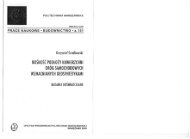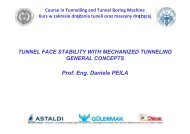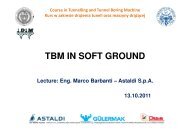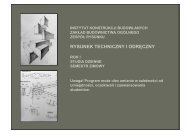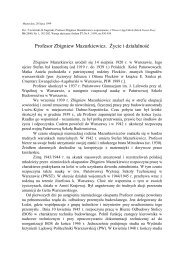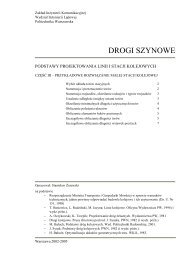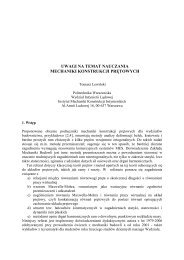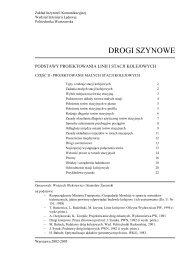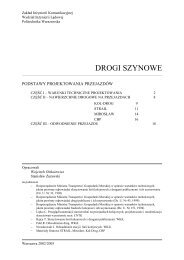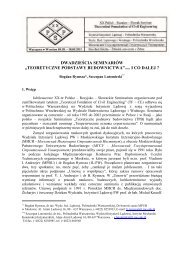Slurry shield TBM
Slurry shield TBM
Slurry shield TBM
Create successful ePaper yourself
Turn your PDF publications into a flip-book with our unique Google optimized e-Paper software.
Course in Tunnelling and Tunnel Boring Machine<br />
Kurs w zakresie drążenia tuneli oraz maszyny drążącej<br />
OVERVIEW ON TUNNEL BORING MACHINES<br />
Prof. Eng. Sebastiano PELIZZA<br />
1
Full face mechanized tunnelling<br />
(continuous ground excavation and spoil extraction)<br />
Continuous spoil<br />
removal<br />
The free span coincides with the last<br />
stretch of the tunnel where the rock is<br />
being excavated and the supports cannot<br />
be installed yet (very variable length,<br />
depending on the <strong>TBM</strong> type: open,<br />
<strong>shield</strong>ed, with or without face<br />
counterpressure).<br />
The advance is performed in two steps:<br />
- Active stroke of the cutting head for the<br />
excavation (and the spoil extraction)<br />
usually1,4 ÷ 1,8 (2,0) m;<br />
- Advance of the whole machine when the<br />
cutting head has been stopped.<br />
2
<strong>TBM</strong> TUNNELLING<br />
Full face mechanized excavation, using <strong>TBM</strong> for the excavation of tunnels in rock.<br />
The main commitment of the <strong>TBM</strong> is to break the rock.<br />
Example of an EPB machine: 1. Cutting wheel, 2. Drive unit, 3. Push cylinder, 4. Air lock, 5. Screw conveyor, 6.<br />
Erector, 7. Screw conveyor gate, 8. Segment handler, 9. Segment crane, 10. Belt conveyor.<br />
Full face mechanized excavation method, using mechanized <strong>shield</strong>s and with<br />
pressure at the face for the excavation of tunnels in soil.<br />
The main problem done by the instability of the ground so the main<br />
commitment of the <strong>TBM</strong> is to create a stable working site at the face.<br />
3
Full face mechanized excavation, using <strong>TBM</strong> for the excavation of tunnels in rock.<br />
The main commitment of the <strong>TBM</strong> is to break the rock.<br />
6
Hard rock <strong>TBM</strong><br />
7
Hard rock <strong>TBM</strong><br />
10
Rock tools<br />
14
copy-cutter<br />
cutter<br />
15
Tunnel reaming machine<br />
19
Tunnel reaming machine<br />
20
Shielded <strong>TBM</strong> advancing<br />
21
Open - face <strong>shield</strong> <strong>TBM</strong><br />
22
Open - face <strong>shield</strong> <strong>TBM</strong><br />
23
Double <strong>shield</strong><br />
24
Double <strong>shield</strong><br />
25
Instant lining<br />
29
Segmental lining – cross section<br />
31
Produzioni medie ottenute con frese a doppio scudo telescopico anche<br />
considerando i fermi per eventi geologici straordinari<br />
Grandori,<br />
331998
Example of an EPB machine: 1. Cutting wheel, 2. Drive unit, 3. Push cylinder, 4. Air lock, 5. Screw conveyor, 6.<br />
Erector, 7. Screw conveyor gate, 8. Segment handler, 9. Segment crane, 10. Belt conveyor.<br />
Full face mechanized excavation method, using mechanized <strong>shield</strong>s and with<br />
pressure at the face for the excavation of tunnels in soil.<br />
The main problem done by the instability of the ground so the main<br />
commitment of the <strong>TBM</strong> is to create a stable working site at the face.<br />
36
The ground moves phisically towards the tunnel<br />
38
Bacino di subsidenza<br />
S<br />
x<br />
−<br />
2i<br />
( x)<br />
= wmax<br />
⋅e<br />
Settlements of the surface<br />
with a shallow tunnel in<br />
loose ground<br />
2<br />
2<br />
40
RISK MANAGEMENT<br />
• Typical patterns of ground failure in urban area<br />
41
Shielded <strong>TBM</strong> advancing<br />
43
MACHINES PROVIDING IMMEDIATE FRONTAL AND<br />
PERISPHERAL SUPPORT<br />
44
Possible failure<br />
mechanism<br />
Compressed air<br />
compressed air<br />
<strong>Slurry</strong> Shield<br />
slurry<br />
Horn (1961)<br />
EPB<br />
excavated soil<br />
45
Compressed air support<br />
46
<strong>Slurry</strong> face support<br />
47
Earth – pressure balance support<br />
48
Soil tools<br />
49
Soil tools<br />
50
Mechanical – support <strong>TBM</strong><br />
51
Mechanical – support <strong>TBM</strong><br />
52
Compressed - air <strong>TBM</strong><br />
53
Boom – type compressed – air <strong>TBM</strong><br />
54
<strong>Slurry</strong> <strong>shield</strong> <strong>TBM</strong><br />
55
<strong>Slurry</strong> <strong>shield</strong> <strong>TBM</strong><br />
chamber<br />
56
Hamburg, Germany - 4th River Elbe Tunnel.<br />
Diameter: 14,200mm<br />
Cutterhead power: 3,400kW<br />
Tunnel length: 2,560m<br />
Geology: Glacial drift, silt and<br />
gravel, sand, boulders<br />
Contractor: Bilfinger Berger AG<br />
Dyckerhoff &<br />
Widman AG<br />
Heitkamp GmbH<br />
HOCHTIEF AG<br />
Philipp Holzmann AG<br />
Wayss & Freytag AG<br />
Ed. Züblin AG<br />
57
<strong>Slurry</strong> <strong>shield</strong> <strong>TBM</strong><br />
1 3<br />
1. Submerged wall<br />
2. Working chamber<br />
4<br />
3. Compressed air<br />
2<br />
4. Pressure bulkhead<br />
58
Fine grained soil<br />
Coarse grained soil<br />
filter cake (d 10 < 0,2 mm).<br />
sandy gravel. stagnation of slurry<br />
60
k=10 [m/s]<br />
<strong>Slurry</strong>-Shield<br />
Permeability „k“<br />
k=10 -3 [m/s]<br />
k=10 -7 [m/s]<br />
EPB-Shield<br />
k=10 -12 [m/s]<br />
61
Conceptual scheme of an EPBS with principal components intervening during the<br />
excavation.<br />
66
EPB with muck control.<br />
1. Excavation<br />
chamber.<br />
2. Screw conveyor.<br />
3. Muck hopper.<br />
4. Single-piston<br />
pumps.<br />
5. Gate valve.<br />
69
Main bearing: inspection and service<br />
71
Screw conveyor: service<br />
72
Earth Pressure Balance machine<br />
74
EPB-Giant for Barcelona Metro Line 9.<br />
Diameter: 12,060mm<br />
Cutterhead power: 4,000kW<br />
Tunnel length: 8,500m<br />
Geology: Granodiorite, sand,<br />
clay, gravel,<br />
boulders<br />
Contractor: Dragados<br />
Necso<br />
ACS<br />
Comsa<br />
Sorigue<br />
78
Mega-Tunnel in Madrid, Spain.<br />
79
Herrenknecht <strong>TBM</strong> S-300, M-30 Madrid, Spain.<br />
Diameter: 15,200mm<br />
Cutterhead Power: 12,000kW + 2,000kW<br />
Maximum Torque: 125,268kNm<br />
Tunnel Length: 3,650m<br />
Geology: Peñuela,<br />
peñuela + gypsum,<br />
massive gypsum<br />
Contractor: Necso<br />
Ferrovial - Agroman S. A.<br />
80
S-300, M-30 Madrid, Spain.<br />
81
k=10 [m/s]<br />
<strong>Slurry</strong>-Shield<br />
Permeability „k“<br />
k=10 -3 [m/s]<br />
k=10 -7 [m/s]<br />
EPB-Shield<br />
k=10 -12 [m/s]<br />
86
<strong>TBM</strong> face stability control<br />
EPB machine example of applications<br />
100<br />
clay silt sand gravel<br />
90<br />
Percentage finer by weigth [%]<br />
80<br />
70<br />
60<br />
50<br />
40<br />
30<br />
20<br />
10<br />
0<br />
0,001 0,01 0,1 1 10 100<br />
grain size [mm]<br />
Aviles (2002) Milano (1) (1996) Milano (2) (1996) Valencia Nivel 3 e 6 (1) (1996)<br />
Valencia Nivel 3 e 6 (2) (1996) Valencia Nivel 4 (1) (1996) Valencia Nivel 4 (2) (1996) Valencia Nivel 5 (1) (1996)<br />
Valencia Nivel 5 (2) (1996) Izmir (1) (1993) Izmir (2) (1993) Izmir (3) (1993)<br />
Essen (1) (1993) Essen (2) (1993) Milano (1) (1998) Milano (2) (1998)<br />
Taipei (1) (1993) Taipei (2) (1993) Avila (2002) Sevilla (1)<br />
Sevilla (2) Barcellona (1) Barcellona (2)<br />
89
CUTTING WEELS<br />
The ratio between the opening area in the cutterhead and the excavated section has a direct<br />
influence on the mechanical-support capacity of the excavation face and on the face-support<br />
pressure control.<br />
Usually, for the SS or hydro<strong>shield</strong>, the cutterhead opening ratio is even more than 50% while<br />
for an EPBS it varies between 20 and 35%.<br />
In fact, the formation of cake in a Hydro<strong>shield</strong> needs a very intimate contact between the<br />
face and the slurry.<br />
On the contrary, the support effect of the EPB principle is based on the “mechanical”<br />
contrast of the muck, which has been accumulated inside the “plenum”. This implies that the<br />
structure of a cutterhead for SS should be lighter than the structure of the one for EPBS: the<br />
greater the opening ratio, the smaller the number of cutter tools which can be installed.<br />
90
The capability for the cutterhead to excavate through boulders has been progressively<br />
improved, with the aim of avoiding the entry of the workers into the working chamber for<br />
manually removing the pieces that are too large to be removed by the machine (BTS, 2005).<br />
However, the situation is that in the presence of many boulders, whose dimensions are close<br />
to the maximum allowable for a certain machine, it is possible to install a “stone crusher” in<br />
an SS, but not in an EPBS.<br />
However, on the EPB cutterhed, which is stronger, it is possible to install disk cutters able to<br />
break the hard rock boulders.<br />
Thank to these reason, the working field of EPB is extending to the larger grain size<br />
distributions as well as to fractured or karstik rocks where it is necessary to stop the ground<br />
water.<br />
91
CUTTING WHEELS - SLURRY SHIELD<br />
Usually, for the SS or hydro<strong>shield</strong>, the cutterhead opening ratio is even more than 50% while for an EPBS it<br />
varies between 20 and 35%.<br />
In fact, the formation of cake in a Hydro<strong>shield</strong> needs a very intimate contact between the face and the slurry.\<br />
92
CUTTING WHEELS - EPB SHIELD<br />
On the contrary, the support effect of the EPB principle is based on the “mechanical” contrast of the muck,<br />
which has been accumulated inside the “plenum”. This implies that the structure of a cutterhead for SS<br />
should be lighter than the structure of the one for EPBS: the greater the opening ratio, the smaller the<br />
number of cutter tools which can be installed.<br />
93
ROCK <strong>TBM</strong><br />
94
SLURRY SHIELD<br />
95
SLURRY SHIELD<br />
96
EPB SHIELD<br />
97
EPB SHIELD<br />
98
EPB SHIELD<br />
99
EPB SHIELD<br />
100
EPB SHIELD<br />
Diameter: 6270 mm<br />
Total Length: 97 m<br />
Total Weight: 615 tons<br />
Installed Power: 2000 kW<br />
101
EPB SHIELD<br />
102
EPB SHIELD<br />
103
EPB SHIELD<br />
104
EPB SHIELD<br />
105
106
In emergency situations, for example a collapse of the face, the<br />
behaviour of the two types of machines is completely different:<br />
in the case of an EPBS, collapsing ground cannot enter the plenum,<br />
which is already full of solid material. If the process is under control, the<br />
<strong>TBM</strong> operator can easily close everything and ask for the intervention of<br />
the tunnel manager in order to take the foreseen countermeasures, foe<br />
example ground treatment all around the critical zone, which, if<br />
successful, could avoid serious consequences on the surface.<br />
The most important thing is that, once the choice is made, a skilled <strong>TBM</strong><br />
driving crew supported by an experienced, control team should<br />
implement a robust and integrated control system to complement the<br />
excavation process.<br />
107
108
Grandori, 1998<br />
109
110
111
Machine not providing<br />
immediate support<br />
Machine providing immediate perispheral support<br />
112



